Onicycosis is fungal damage to the nail plate. The disease can be caused by dermatophyte fungi or microsporia. Fungi negatively affect the construction base of the nail: keratin and, gradually eating it, cause deformation changes.
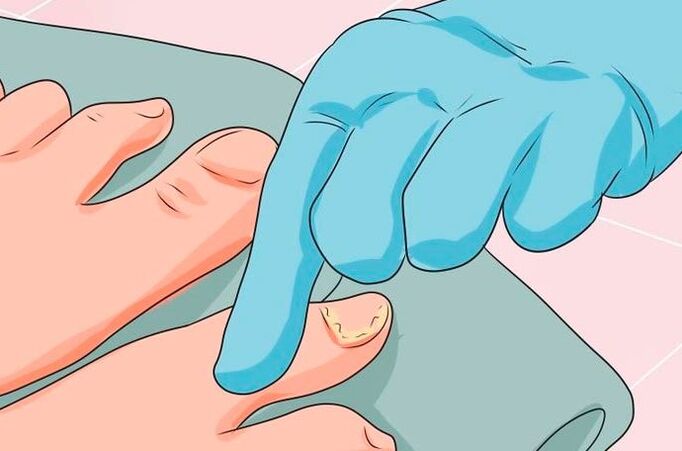
There are the following types of onylomycosis:
- Normotorophic. Changing the color of the nail, the appearance of stripes and spots.
- Hypertrophic. Not only color change occurs, but also a slight deformation. Most of the time, the nail deforms the edges.
- OnicolithicThe nail is destroyed, stunted and rejected.
The nail fungus appears not only due to a decrease in immunity. About 70% of people are infected with a sick person, and most of the time they are relatives. The smallest scales of the skin of the feet fall on household items and, in contact with healthy nail or skin tissues, infect a healthy person.
Very often, the infection occurs through:
- Wipe.
- Sponges
- Towels.
- Carpets
- Shoes.
- Manicure accessories.
When visiting the beach, sauna and bathrooms without sneakers, there is a high risk of infection with a leg fungus. With high humidity and temperature, the infection occurs much more frequently.
It is especially attentive to be in public places where people go barefoot. Fungi are resistant to low and high temperatures, and in the sand of the beach they retain their viability for several months.
Healthy tissues are gradually affected by a fungus. Much depends on the type of pathogen, but some signs allow us to distinguish several main stages of the development of onylomycosis:
- Normotorophic, or initial. There are no pronounced manifestations, at this stage it is difficult to notice the infection with a fungus. The nail turns more, its color can change slightly, small cracks, irregularities on the surface are produced. You can feel burning and itching. This period is easy to confuse with other diseases: psoriasis, liver changes. Therefore, to confirm the diagnosis, it is recommended to contact a dermatologist.
- The hypertrophic form arises if the measures are not taken in the initial stage. The symptoms are becoming more pronounced. The nail thickens and darkens, the shape of the plate is deformed, crumbles and destroys.
- Atrophic or careless. It appears when the infection extends to the cuticle, the latter rejects, inflames and swells. The entire surface of the nail plate changes its color, it is completely separated from the bed. The treatment can be ineffective, the nail is not always saved due to its atrophy.
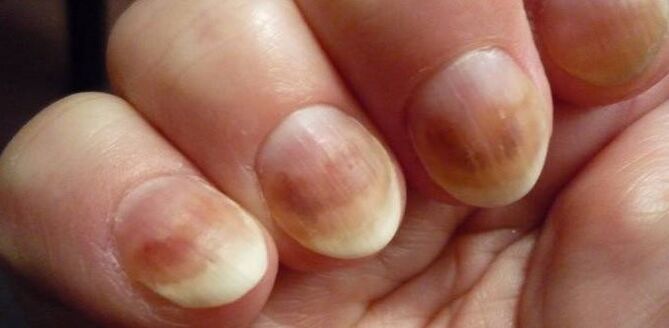
Nail fungus signs:
- The nail plate begins to change the shadow, it becomes opaque. As a result of this, it loses a healthy pink color. When the parasite fungus on the surface, the nail becomes white or yellowish. So most of the time it happens on the fingers. With other types of damage, the nail can take any tone: greenish, gray to black.
- Thickening or exhaustion of the nail plate: when notice that the thickness of the nail has changed, this is a clear sign of fungal damage. At the same time, nail plate loses elasticity, it becomes rough, hard or vice versa too soft, begins to crumble. The normal nail thickness on the fingers does not exceed 0. 5 mm, the nails of the legs up to 1 mm.
- The stratification of the nail plate, its delay behind the surface of the nail bed is a sign of the advanced stage of the disease when the nail structure changes. It is released, unequal, covered with grooves.
- An discomfort: Understand that a fungus has appeared on the nails by unpleasant sensations that accompany this disease. There are severe feelings of itchy and sometimes painful.
- An unpleasant smell: this symptom is especially characteristic of onicycosis on the fingertips of the feet. When they begin to smell unpleasant, despite the regular behavior of hygiene procedures, you must see a doctor.
The fungus of the nails is often accompanied by an extremely unpleasant smell
The general symptoms of the disease are listed above. But how specifically it manifests onychomycosis depends on the type of fungus, which impressed the nail plaque.
Each variety of mycosis has typical signs:
- Fleet fungus: It leads to the rapid thinning of the nail plate. It breaks, begins to exfoliate from the bed of the nail. The tone of the nail first becomes yellowish and then acquires a brown color. In a careless way of the disease, the skin around the nail swells, blushed.
- Molds: Parasitate on the surface of the nail plate, without penetrating more deeply. Thanks to this, this type of disease is easier to treat than the rest. The main sign of the disease is a change in the color of the nail. The tone can be anyone: white, green to gray, black. If the correct treatment does not begin in a timely manner, the fungus extends to other nails and even the skin. There is severe itching, pain, especially when walking.
- Dermatophyte: It develops when the nail is affected by Trichophyton spp. , As well as epidermophyton spp and Microsporum spp. The first signs of this disease: spots or stripes of gray and yellowish tone are formed in the nail plate. As the disease progresses, its amount increases and the nail begins to exfoliate.
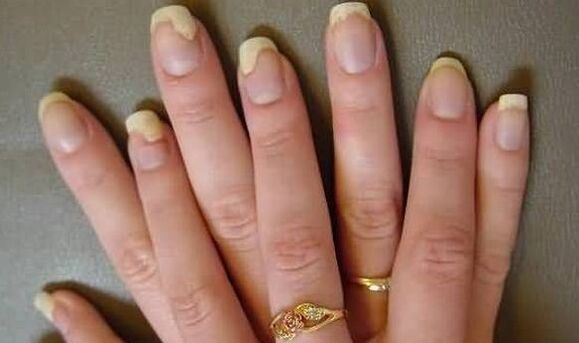
Dermatophyte one of the common forms of nail fungus
Know what type of mycosis was achieved by the nail very important for the correct treatment. The active components of most pharmacological medications are designed to destroy a specific fungus type.
Onychomycosis begins with the injury of insignificant parts of the nail, so many people at the beginning do not pay attention to a change in shadow and the formation of points. In the absence of treatment, mycosis spreads quickly enough, affecting all the large areas of the infected nail, changing healthy nails and infecting others.
There are 3 stages of development of nail mycosis:
- The initial stage: it proceeds without clearly expressed symptoms, the uncomfortable sensations, such as itching, pain, are often absent. Small spots, stripes, internships that are barely distinguishable appear on the nail plate. It is easier to notice them in the thumb.
- The second or progressive stage of onychomycosis: increases the number of spots and furrows, become large and already clearly notable. The color of the nail plate changes, fades and begins to deform.
- The advanced stage: the nail plate completely loses the aesthetic appearance, it is excessively thick or very fragile. The color of the nail becomes yellow, brown, green, black. It is exfolia, there is a risk of a complete loss of the nail.
The first signs of the presence of nail fungi
The sooner it is possible to detect onychomycosis, the greater the probability of rapidly getting rid of this disease. With the competent operational therapy, the body suffers minimally, so when the first symptoms of mycosis appear, you should consult a doctor.
The first signs of nail mycosis appear almost immediately after infection. If after visiting public places such as a pool, a sauna, shower in the gym, the beach, the nails faded, they began to chop a little, then these can be the first signs of onychomycosis.
Healthy nails are practically not susceptible to infection with a fungus. It begins to develop quickly when only in damaged nail plates.
Popular remedies
There are many popular remedies that will help cure the nails affected by a fungus in the initial stage. Consider effective, but at the same time simple recipes.
Sometimes, common iodine can help fush the fungus
- Iodine: daily until the symptoms disappear, apply 1 drop of 5% iodine to the affected nails. The procedure is carried out in the morning, as well as at night. More material about the treatment of iodine.
- 1 teaspoon of iodine, vinegar, glycerol is mixed and diluted with 6 teaspoons of water. The resulting mixture for 10 days often rubs the nails. The composition on the nail plate should be left during the night.
- Vinegar: Prepare a bath diluting 1 part of 9% vinegar with 8 parts of warm water. To rise on your legs or arms for 20 minutes. Perform 7 procedures every two days. More material about vinegar treatment.
- Egg ointment: Place a raw chicken egg in the peel in a glass and pour 9%vinegar at the top. When the peel dissolves, remove the remaining movie and mix the egg with vinegar. The resulting mixture is applied twice a day to the affected areas for 2-3 weeks.
Gallina egg ointment is also quite effective against nail mycosis
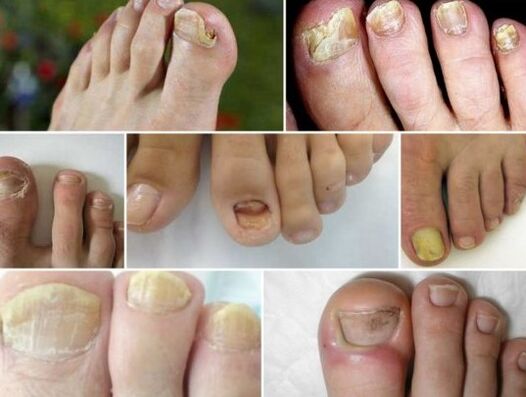
- Hydrogen peroxide: It is diluted in 2 liters of water 2 tablespoons of hydrogen peroxide 3%. To raise your hands or legs, depending on where the fungus is located for 20 minutes. Repeat the procedure for 7-10 days in a row.
- The peroxide compress: to permeate a cotton swab with peroxide, join the nails in which there are signs of the fungus. Before that, the arms or legs should be afraid in the soft drink bath. To prepare it, 1 teaspoon of soda is diluted in 1 liter of water. The compress at the top is wrapped with cellophane or food film and is left for 60 minutes. This is necessary for peroxide not to evaporate. Repeat the procedure for 10-14 days twice a day.
- Propolian tincture: wet a cotton swab in the alcohol tincture of 20% propolis and adheres to the affected areas. Keep the lotion while the composition dries. Repeat daily to recovery. 1-2 The procedures are enough per day.
- Washing dust: The method is suitable for leg treatment. It is necessary to dissolve 100 g of washing powder, which contains many alkali, in 2 liters of water. Hold in such a bath for 15 minutes. Repeat 10-14 procedures while the symptoms disappear.
- Garlic: cut a clove peeled tooth, wet in salt and then grate the nail plate. Repeat twice a day before the disappearance of symptoms.
- Ammonia: diluted in 1 glass of water 1 tablespoon of ammonia. The resulting solution is impregnated with cotton fabric. You need to wrap your legs or arms and leave this compress at night. Repeat the procedure for 7 days a day.
- Onions: grind the onion to the consistency of the suede and join the affected nails for 30 minutes. Repeat twice a day before recovery.
Chopped onions will help to return your nails a healthy appearance
- Mix the chamomile, sage's mint, can take dry or fresh herbs. Put the resulting composition on a foot or glove at night. Herbs must be changed every night. Repeat the procedure in combination with other recipes while the symptoms of the fungus disappear.
- Boric acid: cotton swabs impregnated with boric acid apply to prefabricated nails. You need to keep the lotion for 30 minutes. The procedure is repeated 10 days in a row daily.
- Celandine tea oil and wood: mix these products in equal proportion, soak the gauze bandage with the resulting composition and apply it on the nails for 20 consecutive days for 45 minutes. The recipe is contraindicated in pregnant women.
- Soda: Dilute the soft drinks with a small amount of water to the consistency of the Golla. Apply it on the nails for 20 minutes and then rinse with warm water for 10-12 days twice a day.
- Apple vinegar: dilute with olive oil. The required proportion is 2 parts of vinegar to 1 part of the oil. Apply the mixture to affected nail plates while the nail is growing completely.
- Tea tree oil: APPLY A TOUR OF OIL DROPS ON THE NAIL, while the areas of the fungus affected by the fungus will grow completely.
- Verba: grind 500 g of sprouts of a young sauce, pour 2 liters of water, boil. From the decoction finished three times a week, make hands or legs for 20 minutes to recovery.
- Nettle - Brew 3 tablespoons of ortigas in 400 ml of water. With this decoction, obtain wet tampons and apply them to nail plates twice a day before recovery.
- Mole the mountain ash leaves and put the nails with a thick layer, and then wrap them with a baking movie for 30 minutes. Repeat the procedure daily from 12 to 14 days.
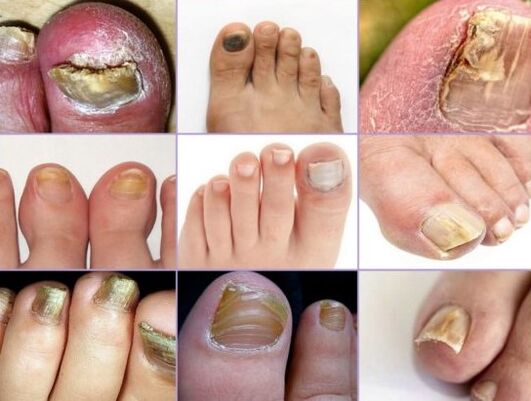
- The fungus of the skin of the feet.
- Reducing immunity.
- Family members suffering from fungal defeat.
- Elderly age.
- Diabetes.
- The presence of microtraumas and buppings.
- Increased leg sweating.
- Unknown and poor shoes of quality.
- The habit of walking barefoot in public places.
- Accommodation and work in a humid climate.
- In the long term with artificial nails.
- General Health.
- Susceptibility to infection.
- The level of humidity and thermal background.
- The type of nail plate (fingertips grow more slowly).
- Distal onylomycosis submarine.
- Lateral onychomycosis.
- White surface onicycosis.
- Proximal onylomycosis tray.
- Total distributing onicycosis.
How can you get an infection with a fungus?
Infection with nail mycosis can occur anywhere: from places of public visit to your own home. It is transmitted directly from people to people, as well as through objects with whom a person suffering from mycosis contacted. The fungus penetrates through microfiets, bruises, another damage.
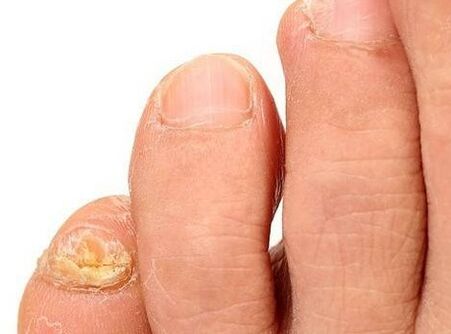
Places where you can infect with mycosis:
- Public places where people often go barefoot, especially if moisture increases there. In such a microclimate, Mikoz retains life for a long time. Examples of such institutions are souls in fitness centers, saunas, bathrooms.
- Directors in stores, sports complexes and other places.
- Manicure rooms: If the teacher does not process the tools badly after having made a manicure or pedicure for a person with a fungus, there is a very high probability that the next client is infected with this disease.
- Visiting and at home: when a person puts clothes, the shoes where the fungus remained, wears a towel that had previously used by onychomycosis. The fungus can be on the nails if you walk barefoot on the floor.
- Beach: In the sand on the beach there are always many fungi disputes. If you walk barefoot, they will penetrate microcks and cannot avoid diseases. In addition, it can be infected on the beach through a solar bed.
- Public transport: Through the handrails, whom the patient touched.
- Buy: While trying the barefoot of the shoes, which previously measured the patient with a nail fungus.
There are great possibilities of infected with a nail fungus in public transport.
In the previous places, it must be extremely ordered to avoid infection.



















